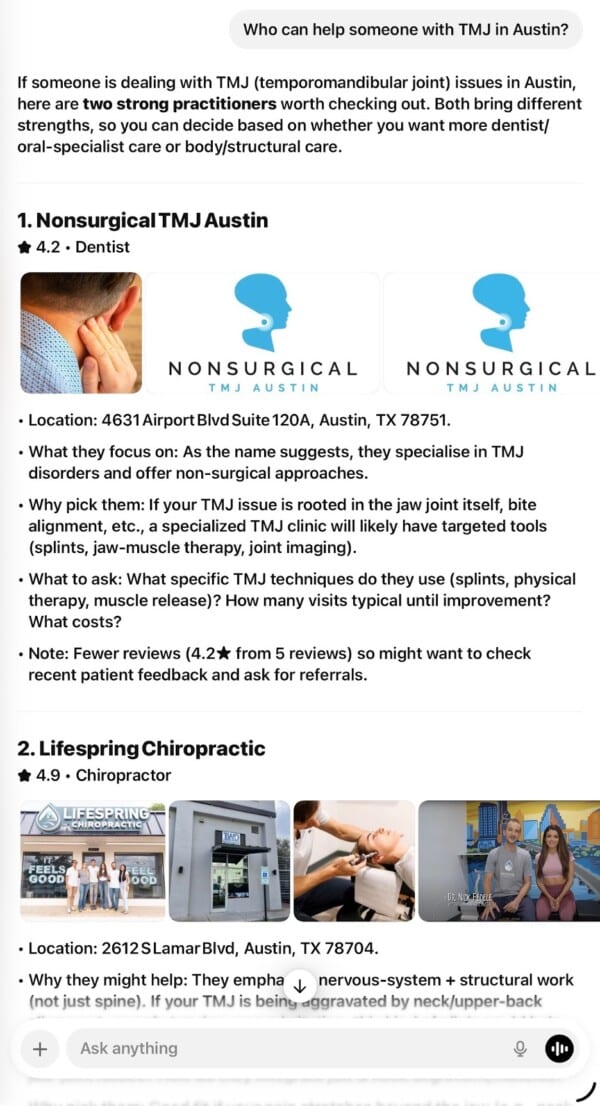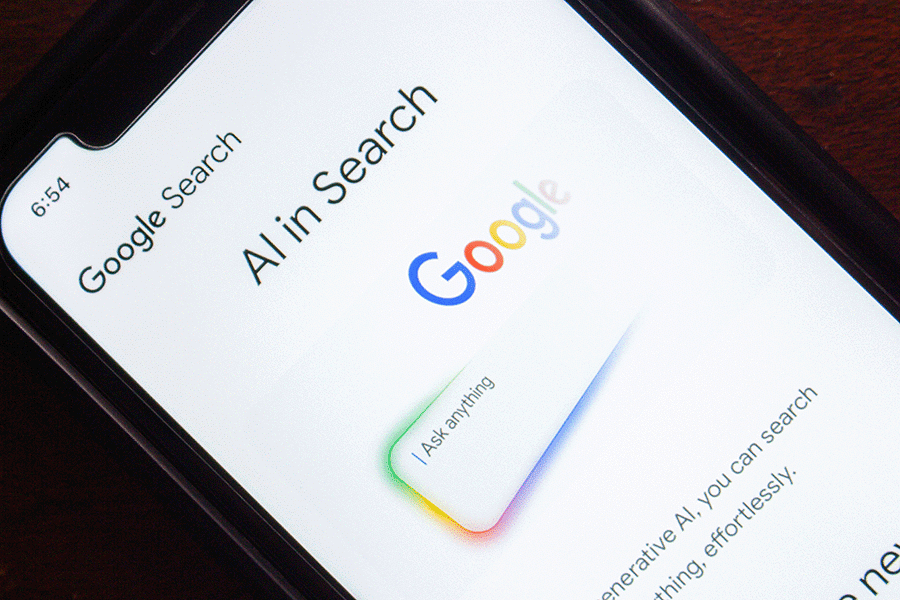For the last decade, local businesses lived and died by what showed up in the map pack.
The strategy was simple. Show up. Get reviews. Optimize your listing. Run some local service ads. Rinse and repeat. If you were a dentist, plumber, real estate agent, or coffee shop, your growth was pinned to three things: Google Maps, Google Ads and Google Reviews.
But just like we’re seeing with the traditional SEO funnel is dying, the local discovery process is changing too. It’s not changing because of another algorithm update. It’s changing because how people ask questions is evolving.
And who they’re asking is changing too.
The New Local Search: Fewer Pins, More Picks
Ask ChatGPT where to get the best tacos in Austin.
You won’t get a map.
You’ll get three or four recommendations, often with summaries like:
“Cuantos Tacos – Michelin‑Guide noted for Mexico City‑style street tacos.
Veracruz All Natural – A favorite for breakfast tacos, fresh house‑made tortillas, and solid streetside taco experience.”
There’s no scroll. No ads. No local pack. Just curated suggestions, often pulled from Yelp, Reddit, Eater, local blogs, and review sites.
That means the battleground for attention is no longer just Google Maps or SEO. It’s what the AI remembers and repeats. It’s who shows up as a top-of-mind name in a machine’s training data or plugin integrations.
Local businesses that built their presence on proximity are now in a world where reputation and recall matter more than radius.
When AI Answers, There Is No Map Pack
Google’s entire local search model was built on visual discovery. Pins on a map. Lists of businesses. User-generated reviews. Click to call. Click to drive.
But when someone types a local query into ChatGPT or gets an AI-generated overview from Google, they don’t see a list of 20 options. They get a handful. Sometimes just one.
The answers are sourced from structured reviews, forum threads, editorial content, and even blog mentions. Yelp, TripAdvisor, Reddit, and niche review sites shape the output. Not your proximity. Not your ad budget. Most likely filled with the voice of customers.
No one is browsing. They’re asking, “Just tell me where to go.”
If your business isn’t in that short list, it doesn’t exist.
Local Visibility Is Becoming a Memory Game
The AI is trained on what’s published and reinforced. So local SEO is no longer just about updating your Google Business Profile or collecting 5-star reviews.
It’s about creating brandable, recallable proof.
The kind that shows up in:
- Reddit threads, like “Best chiropractor in Austin?”
- Yelp reviews with detailed customer stories
- Local blogs and media roundups with honest commentary
- Your own site, structured clearly and consistently
- Third-party listings that are clean, updated, and in agreement
In the future, local visibility will stem from consistency across the web, not just the frequency of your NAP (name, address, phone number) appearing.
What Local Businesses Should Do Now
1. Run Your Own AI Audit
Ask ChatGPT or Perplexity:
“What are the best [your business type] in [your city]?”
“How would someone choose [your business type]?”
“Why would I work with [your business name]?”
If you’re not listed, or listed with outdated info, you have a visibility problem.
2. Get Brandable, Not Just Discoverable
Saying “TMJ treatment in Austin” is generic.
Standing out from every other business that offers TMJ care and having AI share “Why they might help: They emphasize nervous‑system + structural work (not just spine). If your TMJ is being aggravated by neck/upper‑back alignment, muscle tension, nerve irritation, this kind of clinic could help.” This is why the “best chiropractor in Austin,” LifeSpring Chiropractic stands out for TMJ care. They are getting numerous leads weekly for TMJ patients.
AI selects language that’s specific and repeatable, rather than vague, predictable and interchangeable. Say what you do. Say who it’s for. Say why it’s different.

3. Optimize for Language, Not Just Location
Proximity used to get you ranked. Precision gets you picked.
Ensure that your services, differentiators, and unique traits are clearly communicated across your website, listings, and reviews. Not just for humans, but for machines that need to understand what makes you the best option.
4. Own the Narrative, Not Just the Reputation
Reputation used to mean stars and reviews. But in this new era, that’s just the surface.
What matters more is the story people tell when you’re not in the room. And for that story to be worth repeating, it has to be consistent. Not just across platforms, but across people. This is something we discussed in ‘I Think I Swallowed An Elephant’.
This isn’t just about cleaning up Yelp listings or posting on Google. It’s about alignment.
The story your customer reads online should match what they hear when they call your office. It should echo what your staff says on-site. It should be consistent across your emails, signage, packaging, and service experience.
From the stockroom to the boardroom, everyone in your organization should be reinforcing the same clear, credible, and memorable message. This is how (buyer) legends are made. When they do, your customers don’t just leave reviews. They share your story. And that is the story AI learns, repeats, and spreads.
Narrative control in this new era isn’t just about visibility. It’s about integrity.
Local Isn’t Dying. It’s Being Rewritten.
Local search isn’t going away. However, it will look less like a map and more like a conversation.
Instead of “near me,” people will ask, “What’s the best?”
Instead of seeing 20 choices, they’ll get three. Maybe two. Maybe just one.
And the winner won’t be the one with the most reviews. It will be the business with the clearest story, the most consistent presence, and the strongest signals across platforms.
In other words, the one that stopped optimizing for the map and started optimizing for memory.
P.S. Have you tried the new AI enabled browsers from Perplexity and ChatGPT?
- AI Turns Choices Into Decisions, Especially For “Boring” Businesses - November 19, 2025
- From Maps to Memorability: Local SEO Will Bury the Unprepared - October 22, 2025
- The Most Powerful Part of Your Story Is the One You Don’t Tell - May 14, 2025

